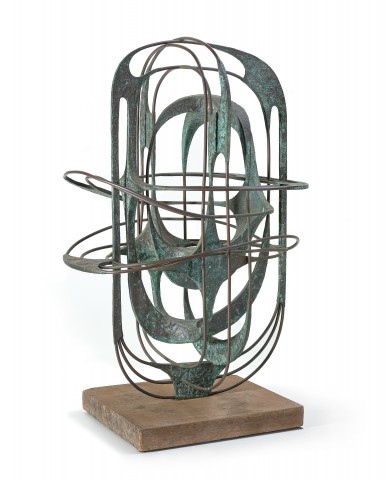MAQUETTE (ADELAIDE TELECOMMUNICATIONS BUILDING), 1971
MARGEL HINDER
beaten copper and copper pipe on wooden base
120.0 x 65.0 x 82.0 cm
James Baker, Brisbane
The James Baker Collection, Christie’s, Brisbane, 2 March 1996, lot 386
William (Bill) Burge, Sydney
The W. R. Burge Collection, Christie’s, Sydney, 6 March 2006, lot 40 (as ‘Untitled’)
Private collection, Sydney, acquired from the above
Marland House Sculpture Competition, Age Gallery, Melbourne, June – July 1971, cat. 29
Frank and Margel Hinder 1930 – 1980, Art Gallery of New South Wales, Sydney, 12 June – 13 July 1980
Lynn, E., ‘Big business peps up the sculptors’, The Bulletin, Sydney, vol. 93, no. 4761, 26 June 1971, p. 50
Free, R., Frank and Margel Hinder 1930 – 1980, Art Gallery of New South Wales, Sydney, 1980, cat. M80, pp. 61, 71 (illus., as ‘Marland House Sculpture Competition’)
Cornford, I., The Sculpture of Margel Hinder, Phillip Matthews Book Publishers, Sydney, 2013, pp. 104, 105 (illus.), 107
Sketch for ‘Three Form Revolve – Form 1’, 1969, copper shim, brass, solder, in the collection of the Bathurst Regional Gallery, New South Wales
Untitled (Free Standing Sculpture), 1972 - 1973, Lyten steel and stainless-steel tubing, Telecommunications Building, Adelaide
By the 1970s, Margel Hinder had an established reputation as a modernist sculptor and like Barbara Hepworth, now invested her considerable talent in public sculpture. Both artists were conceptually ahead of their peers and confident of the role of the contemporary artist in the post-war reconstruction boom, with Hinder becoming one of the few women to create site-specific industrially fabricated sculpture in Australia. Hinder entered her soldered maquettes into numerous sculpture competitions for architectural, monumental and public art, winning those leading to the creation of sculptures for the Reserve Bank, Sydney; the Civic Park Fountain in Newcastle; and in Woden Town Square, Canberra. Thus Hinder’s artworks, at the height of their innovation and impact, were experienced and enjoyed directly by everyday Australians, their dynamic and futuristic forms complementing the roaring progress of urban and technological development.
Working within the framework of Dynamic Symmetry, Hinder’s conception of sculpture was deeply rooted in three-dimensionality. This copper maquette relates to a public sculpture commissioned for the forecourt of the Waymouth Street Adelaide Telecommunications exchange building.1 A complex ovoid, its open form is dynamic with implied centrifugal motion. Ringed like a planet, the criss-crossing and acentric ribs of this ‘revolve’ presented a pleasing expression of interconnected, encircling energies. Found to be an apt metaphor for global telecommunication, this sculpture fortuitously appealed to the architect of a $6M building project, facilitating its large-scale commission and installation in 1972.
In 1947, Frank and Margel purchased Vision in Motion, a landmark publication on International Constructivism written by avant-garde Russian émigré artist Naum Gabo. Gabo’s radical incorporation of implied movement into modern sculpture informed Hinder’s of acentric stringed forms and a ‘space-age’ constructivist aesthetic. As Renée Free noted in 1980, Hinder followed Gabo’s preference for transparency to convey movement without actual motion.2
The linear forms of this maquette elegantly enclose space, their transparency creating an effect of lightness and free flowing motion apparently independent of gravity. Much larger than Hinder’s previous maquettes, this sculpture’s scale is monumental in its own right, encouraging immersive attention to its flow of internal oval forms, the looping ribbons revolving as the viewer walks around the work. This monumentality prompted Elwyn Lynn to remark the work ‘seemed too demanding of space and perhaps needed isolation like a Henry Moore on the hillside.’3
This Adelaide Telecommunications maquette is realised in plate and tubed copper, providing a harmonious textured grey-green patina quite distinct from the gleaming contrast of polished stainless-steel and rusted Lyten steel in its monumental counterpart. This maquette escaped the need for additional stabilising struts at the base, balancing instead on crossed wires. Being viewed completely in the round, this maquette can be enjoyed as Hinder intended, with internal and external graduated ovals seizing light and shadow, concavities and tunnels introducing inner lightness and a hint of the transcendental.
1. Although initial entered to a sculpture competition in 1971 for Melbourne’s Marland House (won by Ken Reinhard), this Maquette formed the basis of a different commissioned public sculpture, erected in Adelaide in 1972.
2. Free, R., Frank and Margel Hinder 1930-1980, Art Gallery of New South Wales, Sydney, 1980, p. 54
3. Lynn, E., ‘Big business peps up the sculptors’, The Bulletin, Sydney, 26 June 1971, p. 50
LUCIE REEVES-SMITH
